A Review Of IKEA’s Foam Mattresses
Being strapped for cash is no reason to be denied a sound sleep, and that’s the point IKEA sets out to prove with their foam lineup. With all its offerings priced under $600, this places IKEA’s foam lineup in the reach of frugal customers who want a temporary sleeping solution, or one to accommodate guests without breaking their wallets.
As is the case with budget products though, you’ll be treading on thin ice as far as durability and support is concerned. It’s better to have an idea of what you’re getting into beforehand, and manufacturer descriptions may not always explain everything cut and dry. Fortunately, you’ve got our informative IKEA foam mattress guide – backed by candid IKEA foam mattress reviews – to help you make an informed decision. Before we get into our buyer’s guide, we’ve put together a list of the best foam mattresses IKEA has to offer, so scroll down below to take a look at our picks!

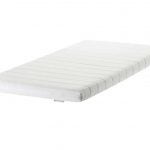
1. Minnesund – Editor's Choice
- Material: Foam
- Core Density (lb/cu.ft.): Polyurethane foam: 1.7
- Thickness: 3 7/8”
- Firmness: Firm
- Sizes Available: Twin, Full, Queen
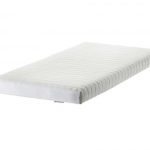
2. Meistervik
- Material: Foam
- Core Density (lb/cu.ft.): Polyurethane foam: 1.7
- Thickness: 4 3/4”
- Firmness: Firm
- Sizes Available: Twin, Full, Queen
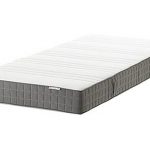
3. Morgedal
- Material: Foam
- Core Density (lb/cu.ft.): High-resilience polyurethane foam: 2.2; Polyurethane foam: 1.7
- Thickness: 7 1/8”
- Firmness: Medium-firm
- Sizes Available: Twin
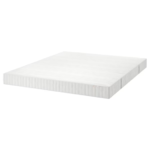
4. Matrand
- Material: Memory foam
- Core Density (lb/cu.ft.): Polyurethane memory foam: 3.1; Polyurethane foam: 1.7
- Thickness: 7 1/8”
- Firmness: Firm
- Sizes Available: Twin, Full, Queen, King
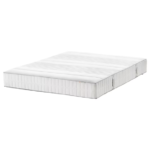
5. Myrbacka
- Material: Memory foam
- Core Density (lb/cu.ft.): Polyurethane memory foam: 3.1; High-resilience polyurethane foam: 2.2; Polyurethane foam: 1.7
- Thickness: 9 ½”
- Firmness: Firm
- Sizes Available: Full, Queen, King
Table Of Contents
Best IKEA Foam Mattresses
1. Minnesund – Editor's Choice
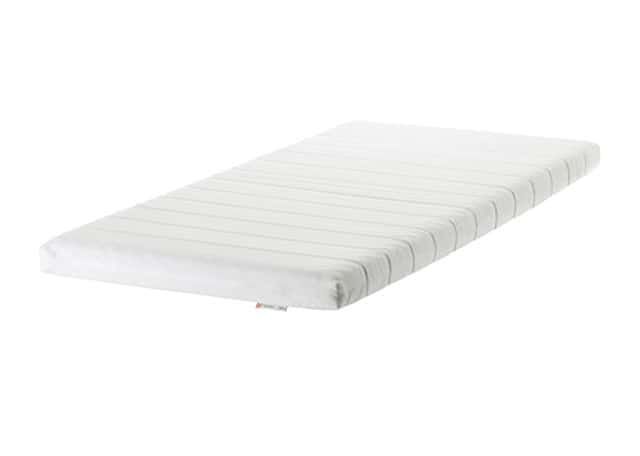
Highlights
- Material: Foam
- Core Density (lb/cu.ft.): Polyurethane foam: 1.7
- Thickness: 3 7/8”
- Firmness: Firm
- Sizes Available: Twin, Full, Queen
Pros
- Affordable
- Available in multiple sizes
Cons
- Not as durable as other foam mattresses
The Minnesund foam mattress from IKEA uses polyfoam in its comfort layer to give you extra plush support while you sleep. Its density is 1.7 lb./cu.ft. and has a thickness of 4.75″, which is likely intended to extend the lifetime of this product (i.e. the period in which it can offer tolerable support and comfort). The padding is polyester mixed with rayon, its cover is cotton/polyester, and the mattress is classified as firm by IKEA. This particular foam mattress is also available in Twin, Full and Queen sizes – a great bonus for budget-focused consumers who are looking to furnish the bedrooms of the whole family.
2. Runner Up – Meistervik
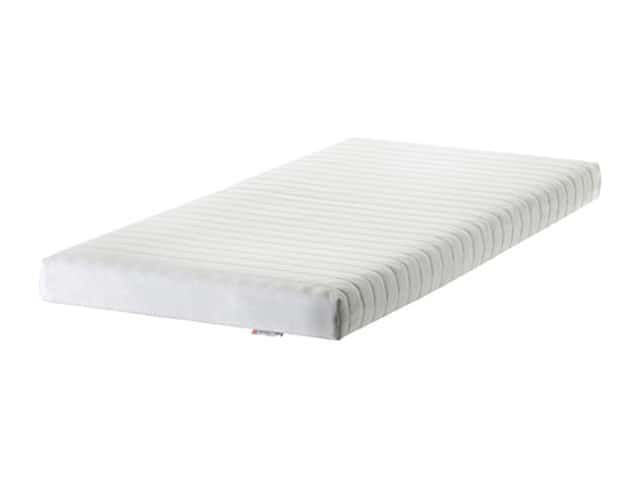
Highlights
- Material: Foam
- Core Density (lb/cu.ft.): Polyurethane foam: 1.7
- Thickness: 4 3/4”
- Firmness: Firm
- Sizes Available: Twin, Full, Queen
Pros
- Affordable
- Slightly thicker than Minnesund
Cons
- Still won’t offer much support/durability compared to more expensive options on the market
The Meistervik is also made with polyfoam in its comfort layer, and has the same density as the Minnesund, 1.7 lb./cu.ft. and a thickness of 4.75″. It comes in Twin, Full and Queen sizes to suit a wide variety of customer needs, and has a polyester and rayon padding with a cotton/polyester cover. This is an extremely affordable, firm foam mattress that’s sure to give you a supportive, restful night’s sleep if you’re a budget-conscious shopper.
3. Customer’s Choice – Morgedal
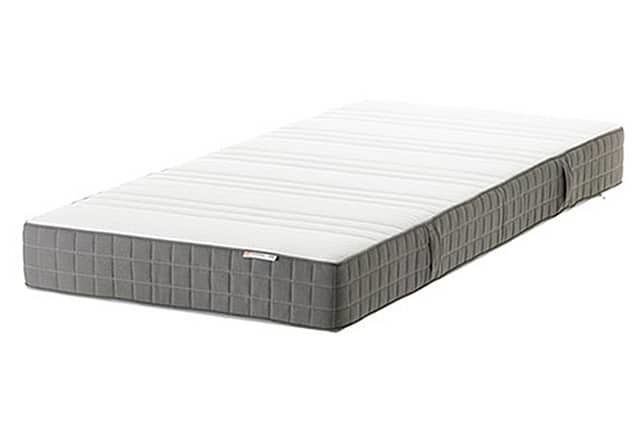
Highlights
- Material: Foam
- Core Density (lb/cu.ft.): High-resilience polyurethane foam: 2.2; Polyurethane foam: 1.7
- Thickness: 7 1/8”
- Firmness: Medium-firm
- Sizes Available: Twin
Pros
- Affordable
- Both medium-firm and firm options available
- High-resilience foam layer somewhat improves durability
Cons
- May begin to sag in a couple years
By using 2.2 lb./cu.ft. ‘high resilience’ foam in its 2.4” comfort layer, and a base layer of 1.7 lb./cu.ft. polyfoam, the Morgedal foam mattress is able achieve better overall durability compared to using the 1.7 lb. foam alone (which is the case with their more affordable offerings). Judging by consumer feedback, this product does perform extremely well for its very reasonable price point. A cotton/polyester blend cover and polypropylene lining completes this mattress’ thickness of 7 1/8″. It’s worth noting that the Morgedal is available in both medium-firm and firm varieties to appeal to a wider range of consumers.
4. Best Firm Support – Matrand
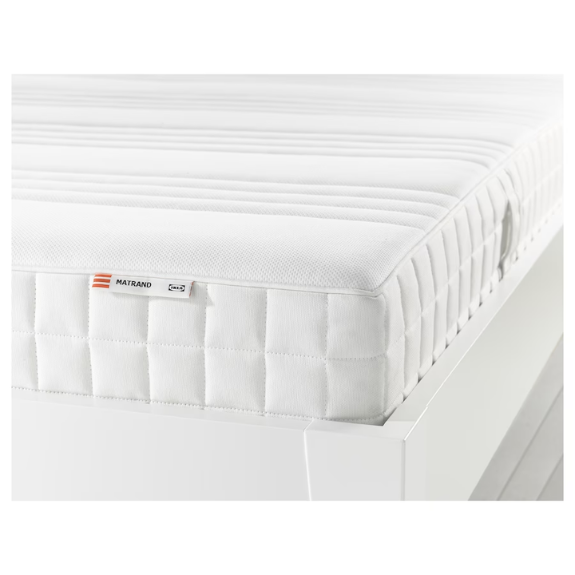
Highlights
- Material: Memory foam
- Core Density (lb/cu.ft.):Polyurethane memory foam: 3.1; Polyurethane foam: 1.7
- Thickness: 7 1/8”
- Firmness: Firm
- Sizes Available: Twin, Full, Queen, King
Pros
- Reasonably priced
- Memory foam yields firm, personalized comfort
- Available in multiple sizes
Cons
- Potential heat retention issues
- Develops impressions relatively quickly
The Matrand foam mattress utilizes 2 inches of 3.1 lb./cu.ft. memory foam for the comfort layer, bolstered by a support layer of 1.7 lb./cu.ft. polyurethane foam. The memory foam density isn’t too generous, you’d need at least 4 lb./cu.ft. to get the true conformity for which memory foam is known. However, for side sleepers and back pain sufferers, it’s still considerably better than having to sleep on tough, springy polyfoam. Based on user feedback, this mattress seems to justify its price point in terms of comfort and support. That said, given the reduced density and greater thickness of the comfort layer, you’re advised to get this only if your BMI is well under 25 – higher than this, and you’ll need a mattress with greater overall thickness to fully support you as you sleep.
5. Best Size Variety – Myrbacka
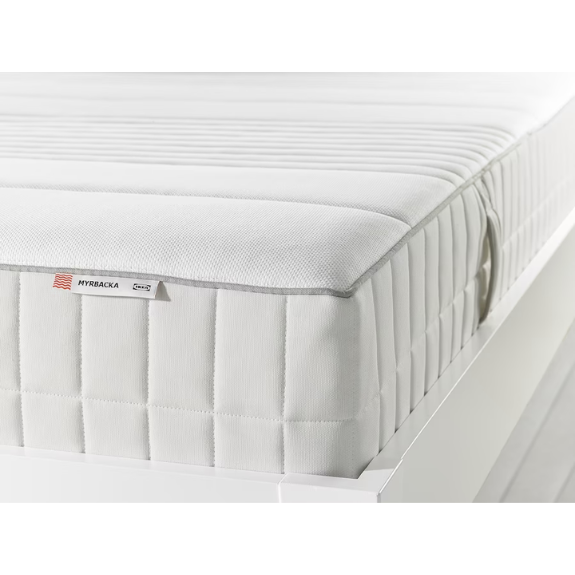
Highlights
- Material: Memory foam
- Core Density (lb/cu.ft.): Polyurethane memory foam: 3.1; High-resilience polyurethane foam: 2.2; Polyurethane foam: 1.7
- Thickness: 9 ½”
- Firmness: Firm
- Sizes Available: Full, Queen, King
Pros
- Memory foam layer supported by high resilience foam to improve durability and support
- Lamb wool filling ensures comfortable sleeping temperature, and gives soft feel
- Higher than average consumer satisfaction
- Available in multiple sizes
Cons
- Expect some loss of shape after a few years
Besides a thicker 3” layer of 3.1 lb./cu.ft. memory foam in the comfort layer, the Myrbacka mattress has an augmented base support layer that incorporates 2.2 lb./cu.ft. high resilience foam. It also includes 1.7 lb./cu.ft. of regular polyurethane foam, as seen in the Matrand foam mattress. The inclusion of the extra dense polyfoam layers improves the weight handling capability of the mattress, so people with a borderline overweight BMI (i.e. 25) can expect to experience enhanced comfort and support.
A frequent complaint with cheap memory foam mattresses (such as this one) is heat retention, and IKEA has addressed this problem by using a pure lamb wool filling to promote thermal ventilation. The filling also lends the otherwise firm mattress a soft feel on the surface. Going through IKEA memory foam mattress reviews left by users, this product enjoys consumer satisfaction in a much greater proportion than is the norm for IKEA mattresses, but you should still be prepared to see noticeable deformation after a few years. It’s available in Full, Queen and King sizes.
Features Of IKEA Foam Mattresses
Comfort Materials
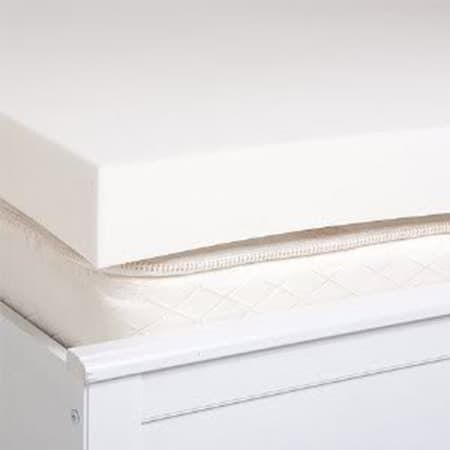
– Polyurethane Foam
The cheaper products incorporate comfort layers made from polyurethane foam with densities ranging from 1.7 lb./cu.ft. (referred to as high density polyfoam in the market) to 2.2 lb./cu.ft. IKEA likes to call it high resilience foam, but I personally think it’s a compromise between price and resilience, since 2.5 lb./cu.ft. is the generally agreed upon minimum threshold for true high resilience.
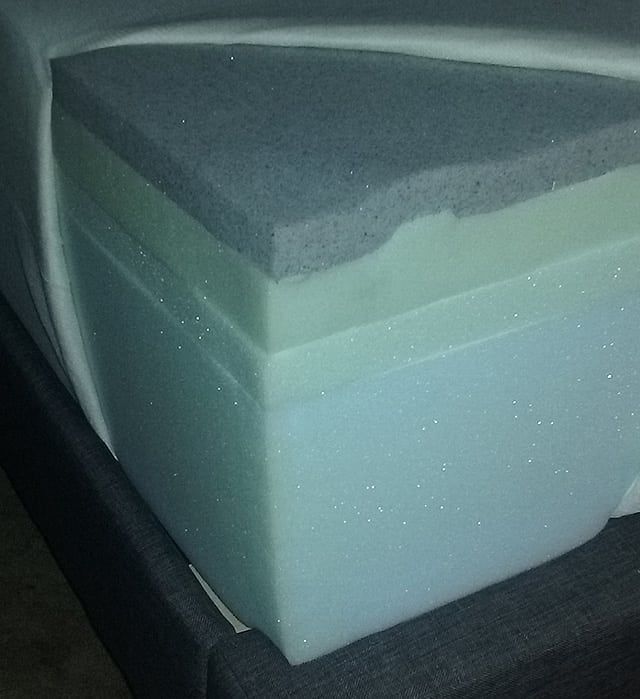
– Memory Foam
IKEA uses 3.1 lb./cu.ft. memory foam layers in a couple of its foam options (these are the most expensive obviously). While this does provide marginally better pressure relief and personalized comfort for sufferers of back pain – don’t expect it to be on par with what high end 5 lb./cu.ft. memory foam mattress offer.
Again the low density of this memory foam means compromised durability, with slight body impressions likely to form in as little as a couple of months – especially if you’re closer to a BMI of 25 (which is perfectly normal).
Support Materials
Some of these mattresses lack a dedicated foam support layer, and quite unsurprisingly, they’re prone to sagging in a couple of years – even when used by those with a BMI under 20. The more expensive models have 1.7 lb./cu.ft. polyfoam support layers which slightly improve their durability. But again, I wouldn’t recommend them for those with a BMI of more than 25.
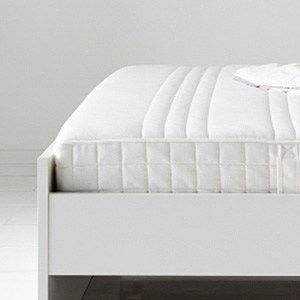
Durability
With lower quality foam materials, it’s recommended that the thickness of the comfort layer doesn’t exceed more than an inch to ensure long-lasting support (or as long-lasting as it can get, in this case). On the other hand, the thicknesses of IKEA’s comfort layers are all greater than 2”, which is another reason for their rapid degeneration, besides the low strength of the foam itself.
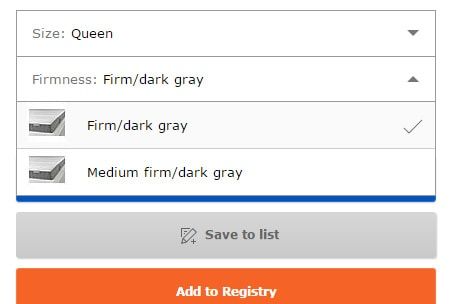
Firmness
These products are available in medium-firm and/or firm variants. If you’re OK with a slightly hard sleeping surface (usually back sleepers), then firm is the way to go. Medium firm mattresses will appeal better to side sleepers / back ache sufferers because of the greater degree of conformity they provide.
Budget
Perhaps the biggest attraction of IKEA’s foam mattresses (or indeed, their entire mattress lineup) is their low cost. The price range of the foam products goes from $90 to $600. Even at its most expensive, it’s a huge bargain compared to market prices from a financial perspective.
For someone on a tight budget who doesn’t want to sleep on an air mattress (keeping them topped off can become a chore after a while, speaking from experience), a proper mattress that doesn’t cost more than a few hundred dollars can be a godsend.

Warranty
This is another positive aspect of these foam mattresses – all of them, in spite of their paltry price tags, come with long-term 25 year limited warranties that cover defects in workmanship and materials. This implies that IKEA still has a reasonable degree of confidence in their craftsmanship, and that they’re at least following some quality assurance procedures. Furthermore, each mattress can be refunded over a period of one year.
All return, refund or warranty requests require the original receipt of purchase, as well as a valid photo ID to be processed. The mattress shouldn’t have been harmed in any way for the claim to be held valid. I suggest getting a mattress protector to ensure your warranty remains valid.
Potential Uses
For regular use by lightweight sleepers on a strict budget
With the explicit understanding that they’ll starting losing shape after a couple of years, you can use these mattresses for everyday sleep if you’ve got a BMI of under 25 (or under 20 for the really cheap ones). You may also use these mattresses for your kids’ bedrooms (ideally under 13) because of the lesser punishment their lower masses will exert.
For infrequent use by guest bedrooms or at a summer cabin
In my opinion, this is the ideal use for these mattresses. Using them for a week or two collectively each year at most, while allowing them to rest and recover their shape for the rest of the duration, will enable them to last you for five years or more (provided you keep them clean and well-maintained).
Tip:
Rotating the mattress may help extend its life by a few months, by allowing some of the sagged regions to regain their shape. Alternatively, you could try this homemade quick-fix to get the most use out of your cheap, sagging mattress.
Conclusion
Objectively speaking, none of IKEA’s mattresses are what most would normally consider long term solutions (and overweight individuals will do well to look elsewhere). Considering that they’re explicitly geared towards budget consumers (you’ll realize that if you read the manufacturer’s company overview), these products do offer a great deal of choice.
From the ultra-cheap Minnesund to the moderately priced Myrbacka, you’ve got an array of sizes, both firm and medium-firm feels, and comfort/support materials of different densities and types. There are plenty of options to find an affordable product that will ultimately meet your sleep preferences.
